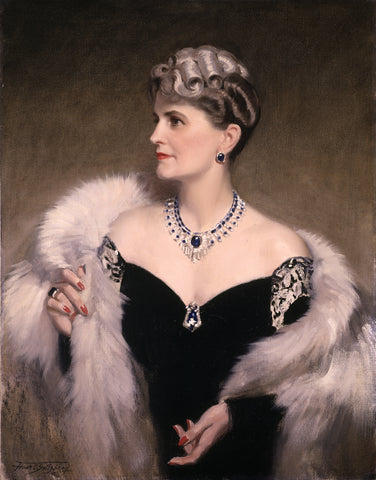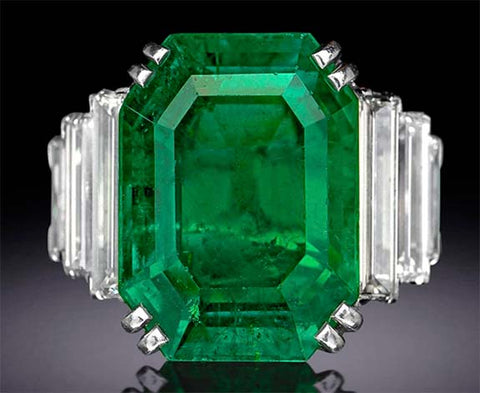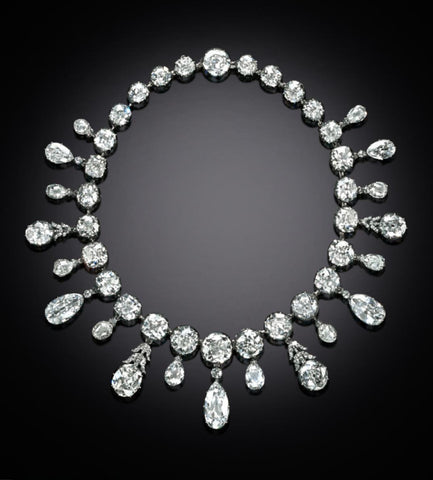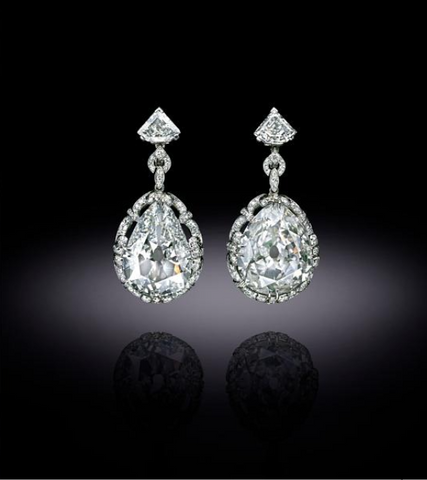Gleaming Echoes of History: The Spectacular Jewelry Collection of Marjory Merriweather Post
Introduction
Marjorie Merriweather Post was one of the wealthiest women in the world during her time, having inherited the Postum Cereal Company (later General Foods Corporation) fortune from her father, C.W. Post, at the young age of 27. Her immense wealth, paired with a sharp eye for exquisite objects, led to a lifelong pursuit of collecting extraordinary pieces of art, including a famed jewelry collection.
Background

Marjorie Merriweather Post wearing a diamond and sapphire parure from 1936/37, with its precise geometric form, is a fine example of the Art Deco pieces for which Cartier is famed. //
In the annals of American history and high society, Marjorie Merriweather Post holds a distinguished position, not merely as a socialite but as a shrewd businesswoman and a fervent patron of the arts and culture. Born in 1887 to Ella Letitia Merriweather and Charles William Post, Marjorie was destined for wealth and prominence. Her father, C.W. Post, was a notable entrepreneur who founded the Postum Cereal Company, which later expanded into General Foods Corporation, an entity that controlled an enviable assortment of well-known food brands.
When C.W. Post took his own life in 1914, Marjorie inherited the company, stepping into an empire valued at approximately $20 million – an astronomical sum for the era, equivalent to around $500 million today when adjusted for inflation. The heiress was just 27 years old at the time, and thus became one of the wealthiest women in the world, overseeing a conglomerate that would continue to grow and diversify under her ownership.
Marjorie's management of the sprawling business empire was not merely titular. She took an active role in steering the company, making pivotal decisions, and maintaining the brand’s dominant position in the market. Her wealth ballooned over the years, thanks to astute investments and savvy management strategies, with estimations of her net worth reaching well into the hundreds of millions of dollars during her lifetime. For a more concrete perspective, by the mid-20th century, she was regularly cited as one of the richest women in the United States.
But beyond the numbers, what was particularly remarkable was Marjorie's manner of navigating through her wealth and social stature. She melded business acumen with a high-society lifestyle, entrenching herself not only in the world of commerce but also in the realms of philanthropy, arts, and culture. Her elegant lifestyle was widely renowned, with opulent estates such as Mar-a-Lago in Palm Beach and Hillwood in Washington D.C., providing vivid illustrations of her boundless affluence and refined tastes.
Her wealth allowed her to indulge in various pursuits, from amassing a world-class collection of art and jewelry to supporting charitable causes, notably in the realms of health, arts, and humanitarian aid. Marjorie navigated through the terrains of a male-dominated business world, societal expectations, and the throes of personal tragedies with an unmatched élan, writing her own script in a world where women of her time were often sidelined.
Notable Pieces and Their Stories
The Maximilian Emerald Ring:

Maximilian Emerald Ring // Chip Clark / Smithsonian Museum
The Maximilian Emerald Ring, one of the star pieces in Marjorie Merriweather Post's astounding jewelry collection, is a jewel steeped in historical significance, intricately entwined with tales of empires and captivating personalities. This exquisite piece centers around a breathtaking 21.04-carat emerald, hailed from the legendary Muzo mines of Colombia, known for producing some of the world’s most prized emeralds with their quintessential vibrant green hue.
The Muzo mines are renowned for their emeralds which are often characterized by their deep green color and a particular clarity that is coveted by collectors and jewel enthusiasts alike. The 21.04-carat emerald in the Maximilian Ring is a perfect exemplification of these desired traits, cut in a rectangular shape which exhibits its verdant hue and magnificent clarity splendidly.
A profound layer of the gem's allure lies in its tumultuous history, most notably being owned by Mexico’s Emperor Ferdinand Maximilian Joseph. The Austrian archduke, declared Emperor of Mexico in 1864, a puppet under the influence of Napoleon III of France, had a fervent fascination with precious stones, which mirrored his opulent and, to some, misguided reign over Mexico. The ring was said to have been with Maximilian when he faced his tragic demise, executed by a firing squad in 1867 following the collapse of his short-lived empire. The emerald ring, somehow, traversed boundaries and times to emerge in the jewelry market of the 20th century.
How the emerald made its way from the historical turmoil of 19th-century Mexico to the polished jewelry boxes of 20th-century American high society encompasses tales that are, unfortunately, largely unrecorded. However, it surfaced in the hands of Marjorie Merriweather Post through the auspices of famed jeweler Harry Winston.
Marjorie was not merely a collector but an appreciator of art, history, and craftsmanship. The acquisition of the Maximilian Emerald was not only a testament to her substantial purchasing power but also a reflection of her inclination towards pieces that whispered tales from the corridors of time. She purchased the ring from Harry Winston, one of the most prominent jewelers of the era, whose clientele spanned royalty, Hollywood stars, and industrial magnates. The exact amount she paid for the piece is shrouded in mystery, but given its historical significance and the value of comparable items, it would undoubtedly be valued at several millions of dollars today.
The Maximilian Emerald now resides in the Smithsonian Institution, donated by Post in 1964, where it continues to captivate visitors with its luminous green allure and its formidable history. Marjorie’s ownership of the piece added another chapter in its remarkable journey, intertwining the stories of an Austrian archduke in Mexico and an American heiress, forever sealed in the facets of this splendid emerald.
The Napoleon Diamond Necklace:

Napoleon Diamond Necklace // Chip Clark / Smithsonian Museum
In the radiant orbit of Marjorie Merriweather Post's elaborate jewelry collection, the Napoleon Diamond Necklace twinkles with particular vivacity, embodying not only astounding craftsmanship but also a cascade of historical narratives and former owners who themselves were emblematic figures in their epochs. Crafted with an arresting assemblage of diamonds totaling 275 carats, the necklace emanates an aura of regality and magnificent splendor that seamlessly intertwines with its storied past.
This exquisite piece was once the possession of Marie Louise, the Duchess of Parma, and the second wife of Napoleon Bonaparte. As the niece of Marie Antoinette, Marie Louise was engulfed in the luminous, yet tumultuous, world of European royalty. The necklace was a wedding gift from Napoleon to his bride in 1810, a symbol of affection, power, and perhaps a political alliance, as their union was as much about diplomatic strategy as it was a marital match. Crafted by the renowned French jeweler Etienne Nitot, the necklace features a plethora of diamonds, intricately arranged in a festoon design, typical of the Napoleonic era, with pendeloque (pear-shaped) diamond drops.
The diamonds, characterized by their remarkable clarity and dazzling brilliance, are set in silver and gold, a common practice in early 19th-century jewelry making, as silver was believed to showcase the whiteness of diamonds more effectively than gold. Each stone was cut using techniques of the period, likely displaying the old mine cut, characterized by a squarish shape with gently rounded corners, a high crown, and a deep pavilion. The exact geological origin of the diamonds remains undisclosed, but given the time period, they might likely have originated from the famed Golconda mines of India, known for producing some of the world’s most illustrious diamonds.
The journey of the Napoleon Diamond Necklace from the vaults of French royalty to the American elite encapsulates a myriad of untold tales. Following the chaotic aftermath of Napoleon’s reign and subsequent rulers, the necklace somehow eluded both plunder and obscurity, emerging in the collections of the esteemed American mining heiress, Evalyn Walsh McLean.
It was from McLean's estate that Marjorie Merriweather Post acquired the illustrious necklace. The transaction details, shrouded in both privacy and the passage of time, leave the exact amount Marjorie paid for the piece unknown. However, given its imperial lineage, expert craftsmanship, and the sheer volume and quality of the diamonds, its value is indubitably counted in the millions. Today, evaluating such a piece would require intricate consideration of its historical significance, provenance, and the quality and size of the diamonds involved.
Now, the Napoleon Diamond Necklace finds its home in the Smithsonian Institution, where it continues to be an object of admiration and wonder, as much for its physical beauty as for its remarkable historical voyage. Through times of war, empire, and social evolution, it has traveled through the hands of rulers and socialites, each owner, including Marjorie, adding a new chapter to its undying legacy.
The Marie Antoinette Earrings:

Marie Antoinette Diamond Earrings // Chip Clark / Smithsonian Museum
The mystique and historical gravity that imbue the jewelry of Marie Antoinette, the famously extravagant and ill-fated queen of France, have fashioned tales that have traversed through time and space, indelibly intertwining with the owners who have been captivated by them. Particularly, a pair of diamond earrings, once draped from the lobes of the queen, carry with them the weight of regal allure and the poignancy of her tragic demise. Later, these luminous pieces found a steward in Marjorie Merriweather Post, an American socialite and businesswoman, weaving a narrative that bridges epochs and continents.
Marie Antoinette, renowned for her penchant for exquisite jewelry, owned a pair of diamond earrings of notable fame and grandeur. Each earring was set with a spectacular diamond – one approximately weighing 14.25 carats and the other around 20.34 carats. Both stones, exhibiting a drop-like pendeloque cut, symbolized the epitome of 18th-century European luxury. Set in silver, which was favored for its ability to reflect and amplify the stones’ brilliance, these diamonds still resonate with the luminosity and elegance that once beguiled the French court.
Post-revolution, tales of the earrings’ journey through the annals of time vary, with some suggesting that they were deftly secreted out of France amidst the chaos of the revolution, passing through generations of royals and nobles before entering the opulent domain of the 20th-century elite. The intricate backstories that enshroud these pieces are woven with threads of both historical facts and enticing myths, as they meandered through various epochs, each era enshrouding them with an additional layer of speculative allure.
In 1887, the entirety of France's Crown Jewels was auctioned, and similarly, Empress Eugenie liquidated her personal jewels between 1870 and 1872, following her exile to England. Subsequent to these events, it appears likely that the Grand Duchess Tatiana Yousupoff of Russia obtained them. Pierre Cartier, the esteemed jeweler, procured the diamond earrings in 1928, with their authenticity vouched for through an affidavit by Russian Princess Zenaide Yousupoff and her son, Prince Felix Yousupoff. The document affirmed that the earrings were originally the possession of Queen Marie Antoinette and had remained unaltered during their time within the family. Marjorie Merriweather Post took ownership of the earrings from Pierre Cartier in October of 1928. Although Cartier asserted that the settings were original at the point of sale, there is no definitive record confirming whether they were modified or replaced in the preceding century. The transaction details pertaining to the acquisition have been kept confidential, but it is conceivable that the earrings, given their substantial size, quality, and historical importance, commanded a figure that aptly mirrored their intrinsic and extrinsic value.
In recognizing the paramount historical and material value of these earrings, Post in 1964 graciously bequeathed them to the Smithsonian Institution. The current value of Marie Antoinette’s diamond earrings, considering both the provenance and the physical attributes of the diamonds, is immeasurable. In pure financial terms, the two sizable and historically significant diamonds would undoubtedly be evaluated in the multimillion-dollar range. Yet, the intangible aspect of their history, having graced the presence of one of history’s most iconic monarchs, renders them priceless.
Today, they reside in the National Gem Collection of the Smithsonian Institution, where they are displayed not merely as spectacular gemological specimens but as tangible fragments of a bygone era, encased and yet untamed, whispering tales of majesty, revolution, and the enduring allure of beauty amidst the ceaseless march of time. From the tragically opulent world of Marie Antoinette to the influential and entrepreneurial sphere of Marjorie Merriweather Post, the earrings serve as a gleaming conduit through which stories of disparate times and personalities are enchantingly entwined.
Acquisition Journey and Sources
Marjorie often bought her jewelry from prestigious houses like Cartier, Harry Winston, and Van Cleef & Arpels, demonstrating her exquisite taste and appreciation for craftsmanship. Her travels to Europe, Russia, and various parts of the world also enabled her to directly acquire pieces from local artisans and estate auctions.
The purchases were not only mere acquisitions but also a reflection of Marjorie’s engagement with history, royalty, and her personal expressions of beauty and status.
Legacy and Display
Marjorie Merriweather Post’s jewelry collection stands as a testament to her persona, embodying her love for beauty, history, and luxury. Today, a significant portion of her collection, including jewelry, art, and other personal belongings, is displayed at her former estate, Hillwood, located in Washington D.C., now a museum that offers an intimate look into her lavish lifestyle and impeccable taste.
Conclusion
A thorough exploration of each piece in Marjorie's jewelry collection, intertwined with her biography and social milieu, would offer a rich tapestry of tales involving luxury, history, and a woman’s expression of power and prestige in an era dominated by men.

Leave a comment